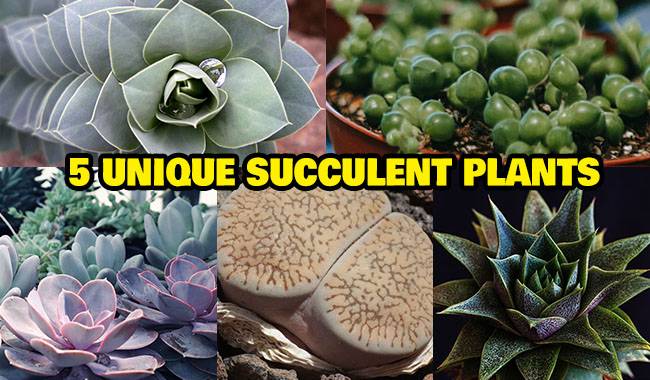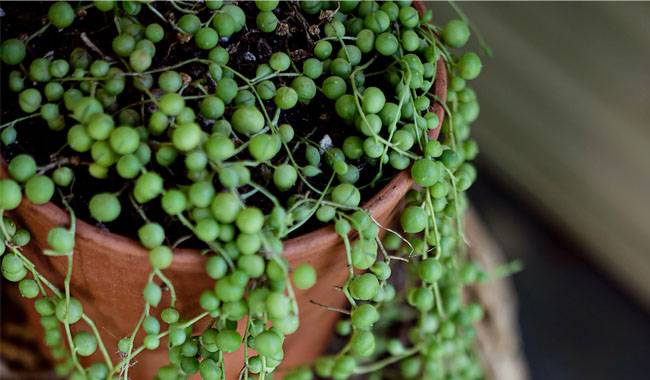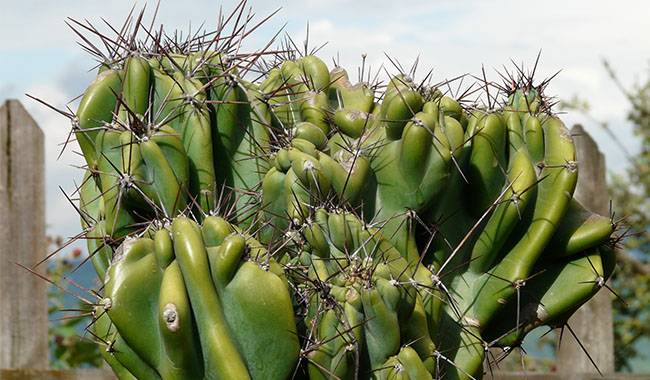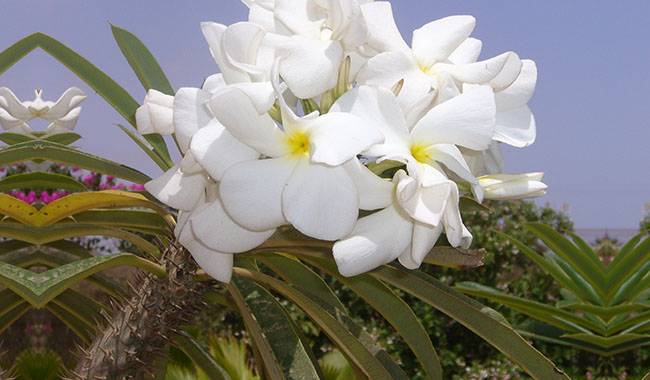
Pachypodium is a genus of arboreal plants in the family Apocynaceae. It can be found naturally in the arid regions of Madagascar, Australia, and Africa. The genus includes 23 species. pachypodium translates to “thick leg” in Greek, as this shrub has a fleshy trunk covered with prickles. These are the most common characteristics of the genus and can be considered as distinguishing features. Under natural conditions, it can grow to about 26 feet (8 m) tall, and its trunk reaches a diameter of 60 inches (1.5 m). However, when grown as a house plant, the shrub does not exceed 40 inches (1 m) in height.
CHARACTERISTICS OF PACHYPODIUM
Pachypodium is a genus of fleshy, thorny trees and shrubs. Although there are many differences between species and varieties, they all have a thick trunk in which a certain amount of liquid accumulates in case of drought. Species in the genus vary greatly in appearance, from cactus-like to bottle-shaped dwarfs. Almost all species of the genus have spines, in groups of 2-3, arranged in a ring or spiral around the trunk. Only some species of the genus do not form branches, while rather a strong branching characterizes others. The genus differs from other members of the family Apocynaceae in that its sap is translucent rather than milky, but it is still poisonous. When grown under domestic conditions, Pachypodium varies in height from 12-60 inches (0.3-1.5 m) and has a lifespan of 3-15 years.
This shrub contains a toxic sap. If it gets on mucous membranes, it can cause them to become irritated, and this sap can also corrode wounds on the skin. Therefore, skin areas splashed with sap should always be rinsed off with plenty of running water.
The pachycaul trunk is a morphologically enlarged trunk that stores water to survive seasonal droughts or intermittent root drying in exposed, dry, and rocky conditions. However, there is considerable variation in the habit of the plant body, all Pachypodium exhibit pachycaul growth. The variation in habit ranges from dwarf flat plants to bottle-shaped shrubs to dendritic trees.
A second general characteristic of Pachypodium is the spines or the presence of spines. These spines are found in pairs or groups, usually arranged in rings or whorls around the tree’s trunk. The spines appear with the leaves and, like the leaves, have a short period of growth before they stop growing and harden. However, spines do not regenerate, so weathering and wear can wear away all but the youngest spines on older specimens – leaving smooth trunks and branches.
To some extent, branching is a characteristic of the genus. Caution is needed in over-attributing this character. Pachypodium namaquanum is usually unbranched. Pachypodium brevicaule has no obvious branching and may have evolved an alternative branching in which leaves, spines, and inflorescences emerge from the nodes. In general, elasmobranchs are rarely branched. Individual plants of the same species show great variation in branching morphology due to environmental stresses and factors contributing to branching even within small areas.
Unlike many members of the Celastraceae family, including some members of the superficially similar Adenium, Pachypodium species do not exude a milky sap. Instead, the sap is always transparent.
HOW TO TAKE CARE OF PACHYPODIUM PLANTS AT HOME
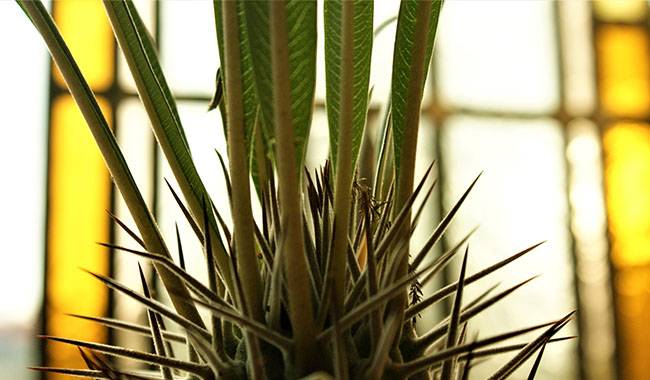
Light
Pachypodium needs plenty of light, but direct sunlight will not harm it. In summer, it is recommended to bring it into the fresh air (garden or balcony), but it needs to adapt little by little to its new environment. If you want to choose a suitable window, it is best to choose one facing southwest, south, or southeast. When the short days of winter are followed by spring, the plant should also get used to direct sunlight little by little.
Temperature
The shrub responds well to frequent ventilation, as it likes fresh air, but it needs to be protected from draughts. In summer, Pachypodium’s air temperature requirements do not differ, and it can grow and develop normally, both at 60 °F (18 °C), and at 82 °F (28 °C). In winter, when he has a dormant period, he should be moved to a cooler place 60-64 °F (16-18 °C).
How to water
The care of this plant is very simple when grown in indoor conditions. Water moderately in spring and summer and keep the potting soil slightly moist. If there is not enough water, the leaves will fall off, and the plant will be less attractive. If there is too much water, it will be painfully elongated, adversely affecting its appearance. Water as soon as the substrate dries to a depth of 10 mm. Suppose you cultivate short-stemmed Pachypodium, water sparingly throughout the year. If the leaves fall off and stop watering completely, they will grow back in only about 1.5 months. Don’t forget that this plant should only be watered with tap water.
Air humidity
This flower does not need high air humidity. However, we suggest moistening it from time to time with well-distilled room temperature water in a sprayer and cleaning all its leaves with a moist, soft cloth or sponge beforehand.
Feeding
Fertilize such flowers as early as possible in spring, after the bush has started to grow new shoots, and until mid-autumn. Use a solution of cactus fertilizer that should be applied every 4 weeks on a pre-watered substrate. Do not apply fertilizer for 4 weeks after transplanting or if the bush is diseased. Stop feeding completely until the plants go dormant. Do not fertilize again until the following spring.
Transplanting Pachypodium
When Pachypodium is young, it needs to be transplanted annually into a larger container, which should be done in the spring. Mature plants can be replanted less frequently, usually once every 3 or 4 years. A medium acidic cactus potting soil is best for growing this flower. Such a substrate can be made by yourself. It combines leaves and bog soil, and even coarse-grained river sand (1:1:1). To make the potting soil well-drained, charcoal or brick chips can be added. Before planting, make a good drainage layer in the new pots by mixing swollen clay pebbles, which should fill 1/3 of the pots.
Be very careful when transplanting, as you can easily injure the root system of the shrub. If the flowers do not have any diseases, replant them in a new container and cover the gaps with a pre-prepared substrate (see above). If the shrub has diseased roots, the remnants of the old potting soil should be gently removed, then all dry or rotting areas should be cut out, and crushed charcoal sprinkled over the wounds. Then transfer the plant to a new pot.
Pachypodium flowering
Pachypodium is a slow-growing plant, so it will not flower for the first time until it is 6 or 7 years old. However, it may not flower at all if it is not properly cared for or taken care of. However, with proper care, preventing drafts, giving adequate nutrition and timely watering, and giving the plant a proper location in the room, you may be able to get the plant to bloom.
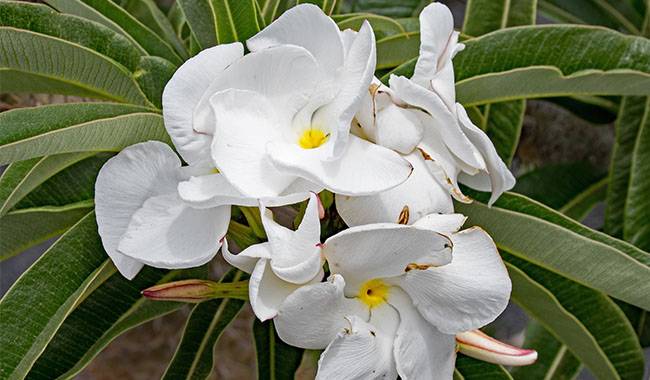
PROPAGATION OF PACHYPODIUM
Growing from seed
Pachypodium can be propagated by seeds (reproduction), but you should note that it is quite difficult to obtain seeds of this plant by yourself in indoor conditions. Seeds are sown into the substrate by 5 mm, and the container should be covered with aluminum foil or glass. Then place the seeds in a cool, well-lit place – about 68 °F (20 °C). When the first seedlings emerge, the cover should be removed, but this should be done gradually to allow the plants to adapt to the new conditions. Once the seedlings are firmly established, they should be put into individual pots and given the same care as mature plants. Before choosing this method of propagation, you should be aware that seedlings grow very, very slowly.
Propagation by seeds
This plant can be propagated by cuttings, but such cuttings rarely root properly. However, it is known that it has successfully rooted by cutting the top part of a rotting shrub from the base. To do this, cut the top portion at the height of 6 inches (15 cm) with a pre-sterilized, very sharp tool, cover the cutting with crushed charcoal, and plant the plugin the soil mixture in which the adult Pachypodium was grown (see above). Place the plugs in a well-lit place.
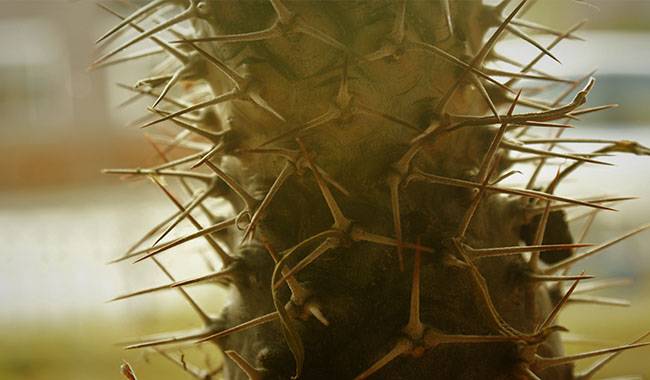
PESTS AND DISEASES OF PACHYPODIUM
Diseases
When grown in indoor conditions, Pachypodium is very sensitive to excess moisture, which manifests itself in the appearance of various rots. To protect the shrub from fungal diseases, you should always water it properly. You should also know that this succulent plant tolerates drought more easily, but waterlogging in the substrate can cause stem rot and thinning, as well as darkening and loss of leaves. As soon as you notice the shrub rotting, you should stop watering it and place it in a warm place. A fungicidal solution should be sprayed on the plant and potting soil and the watering regime should be reviewed to prevent a recurrence.
Harmful insects
If the humidity in the room is too low, spider mites will settle on the plants and suck the cytosol from the shrubs. It is almost impossible to see this mite with the naked eye, but a clear sign that a plant has been invaded by it is the appearance of fine spider webs on its surface. To remove this pest, Pachypodium should be rinsed well under a warm shower, and the room’s humidity should be increased. To do this, moisten the plants every evening with warm water from a sprayer. If the number of mites on the shrubs is very high, you can use acaricides such as Actellic (Pirimiphos-methyl), Dicofol to kill them.
Thrips will settle on Pachypodium if the room is relatively hot and the humidity is low. This pest also feeds on the cellular sap of flowers. In this case, light-colored dots and silvery streaks will form on the front surface of the leaves. The pest is located on the back of the leaves. This pest can be treated with the same products used to control spider mites.
More Related Information About Houseplants




